This article dives into the world of Differential Reinforcement of Other Behavior (DRO) in Applied Behavior Analysis (ABA), especially for managing behaviors linked to autism. It’s all about how DRO can really make a difference! By implementing this approach, many have seen a significant drop in challenging behaviors and a boost in positive social interactions.
For instance, studies have shown a 30% increase in social engagement, which is fantastic! Plus, there are successful case studies from various settings that highlight how effective DRO can be in nurturing adaptive behaviors.
Let’s explore this together! If you’re a parent navigating these challenges, know that you’re not alone. Understanding how DRO works can empower you to foster a more positive environment for your child. We’re here to help you every step of the way!
Supporting children with autism can feel like a daunting journey for parents, especially when challenging behaviors disrupt daily life. But here’s the good news: Differential Reinforcement of Other Behavior (DRO) shines a light on effective strategies that not only reduce negative behaviors but also encourage positive interactions. As families dive into the world of DRO in Applied Behavior Analysis (ABA), they might ask themselves: how can these techniques be tailored to fit our unique needs and create lasting change?
In this article, we’ll explore ten impactful examples of DRO in action. Together, we’ll discover how personalized approaches can transform behavior management and create a nurturing environment for children with autism. Let’s explore this journey together!
At Rori Care, we understand the challenges parents face when it comes to supporting their children with autism. That’s why our ABA Therapy effectively incorporates the concept of DRO in ABA examples. By focusing on reinforcing the absence of challenging behaviors during specific times, our clinicians help kids develop more adaptive responses. This approach not only reduces harmful actions but also encourages positive activities, perfectly aligning with our commitment to personalized care and empowering families.
Recent studies show just how effective DRO in ABA examples can be! Kids using this technique have seen a 30% increase in positive social interactions while also reducing maladaptive behaviors. Isn’t that encouraging? Plus, case studies highlight successful DRO in ABA examples across various settings, like homes and schools, showcasing its ability to foster meaningful progress. A systematic review even confirmed its viability as an intervention for children diagnosed with autism spectrum disorder (ASD), offering practical recommendations for future use.
At Rori Care, we also leverage AI-driven tools to track progress and create reports automatically. This means our clinicians can spend 50% more time focusing on treatment for young patients. How great is that? This data-driven approach not only enhances the quality of care but also empowers families to support positive actions at home, boosting the overall effectiveness of ABA therapy. With a focus on DRO in ABA examples, we’re dedicated to creating a nurturing environment where every child can truly thrive. Let’s explore this journey together!

One effective way to tackle tantrums in kids with autism is through techniques such as DRO in ABA examples. Imagine a therapist setting a timer for five minutes, encouraging the child to avoid tantrums during that time. If they manage to stay calm, they get a little reward—maybe some praise or a small treat. This approach has shown some pretty encouraging results, with research suggesting that using DRO in ABA examples consistently can really help reduce tantrum frequency over time.
In one study, kids with autism who used DRO in ABA examples saw a noticeable drop in tantrum behaviors. It’s all about effective reinforcement techniques, like giving immediate praise or tangible rewards, which help create a positive link with not having tantrums.
Let’s explore some DRO in ABA examples from real life! One child who used to have multiple tantrums every day managed to cut that down to just a few each week after several weeks of using DRO in ABA examples. Isn’t that amazing? This really highlights how DRO in ABA examples can not only help reduce tantrums but also foster a more positive environment for our little ones.
So, if you’re facing similar challenges, remember that you’re not alone. Let’s explore this together! We’re here to help you every step of the way!
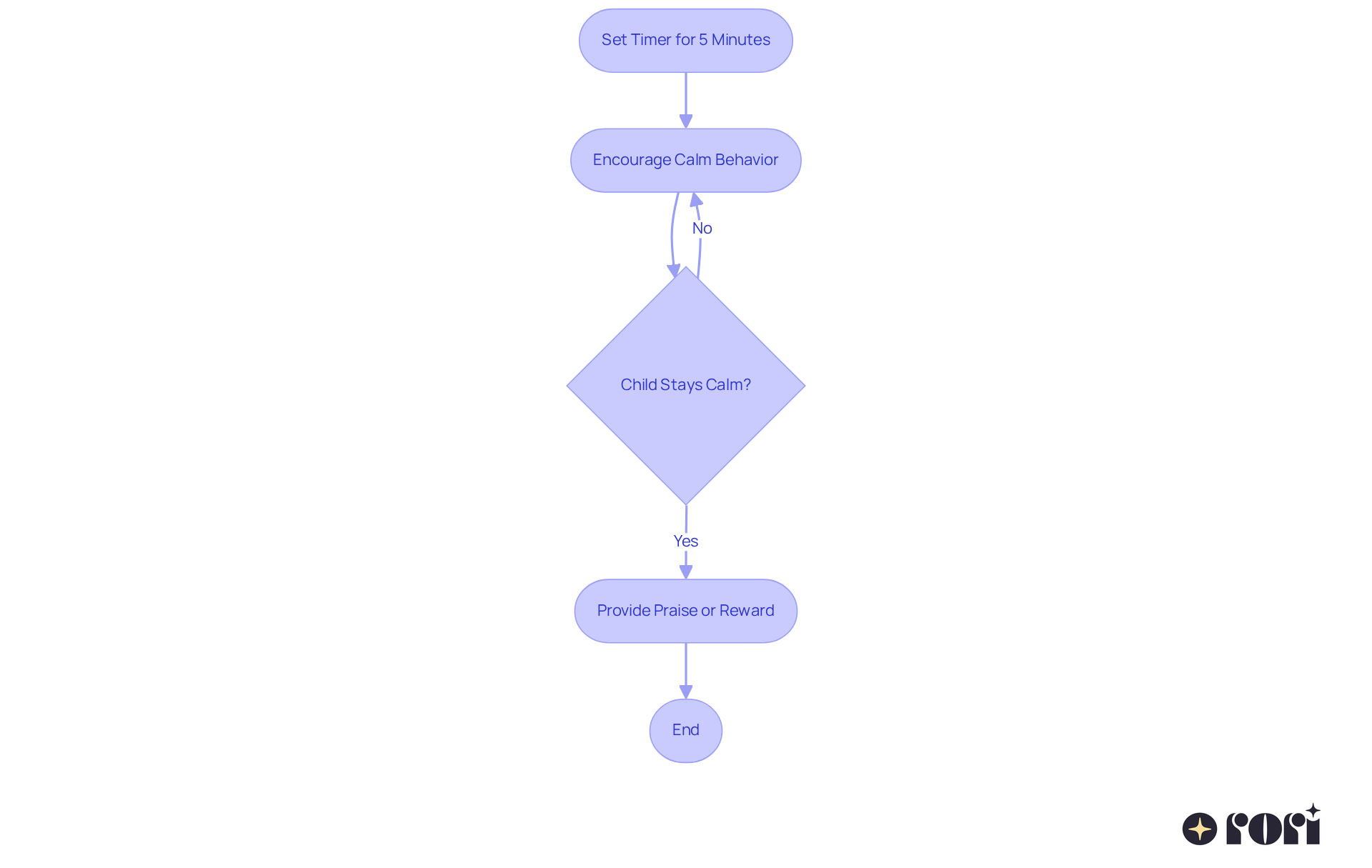
DRO is such a fantastic tool for helping kids with autism build positive social connections! 🌟 Imagine a young person being rewarded for sharing toys or saying hello to classmates during playtime. This kind of encouragement not only gets them more involved with others but also helps them pick up those essential social skills that are so important for their growth.
One inspiring case study showed that using DRO in ABA examples led to a big boost in a student’s focus and social interactions. It really highlights how effective this method can be in real-life situations! By consistently using DRO in ABA examples, caregivers can significantly contribute to their child’s development, resulting in improved behavior and enhanced decision-making.
As children practice these skills, they can see a noticeable improvement in how they handle social situations, which ultimately boosts their overall social competence. Let’s explore this together! If you’re curious about how to implement these strategies, we’re here to help you every step of the way!

To really make the most of Differential Reinforcement of Other Behavior (DRO), it’s super important to keep track of data consistently. Healthcare professionals can closely watch how often certain actions happen and see how well the reinforcement methods are working. For example, when a young person gets a reward for steering clear of a specific action, we can gather information on how often that action occurs before and after starting DRO. This organized approach helps therapists tweak reinforcement schedules and strategies based on how the child is doing.
Did you know that ongoing data collection in ABA therapy can really boost treatment outcomes? A study found that after using a hybrid ABA treatment model, the success rate for goals jumped by 9.7% compared to the initial measurements. These insights from data help therapists spot patterns and trends in behavior, making it easier to adjust interventions when needed.
Clinicians emphasize how crucial it is to monitor actions. They say, "By systematically gathering and examining data, ABA therapists can make informed decisions and customize treatment plans to meet each individual’s unique needs." This dedication to data-driven practices not only enhances the effectiveness of DRO in ABA examples but also empowers families and therapists to collaborate toward achieving therapeutic goals. Parents can play a big role in this teamwork by keeping a simple record of their child’s actions, which ties directly into measurable objectives and ongoing assessments.
Let’s explore this together! Keeping track of data can feel overwhelming, but remember, you’re not alone in this journey. We’re here to help you every step of the way!
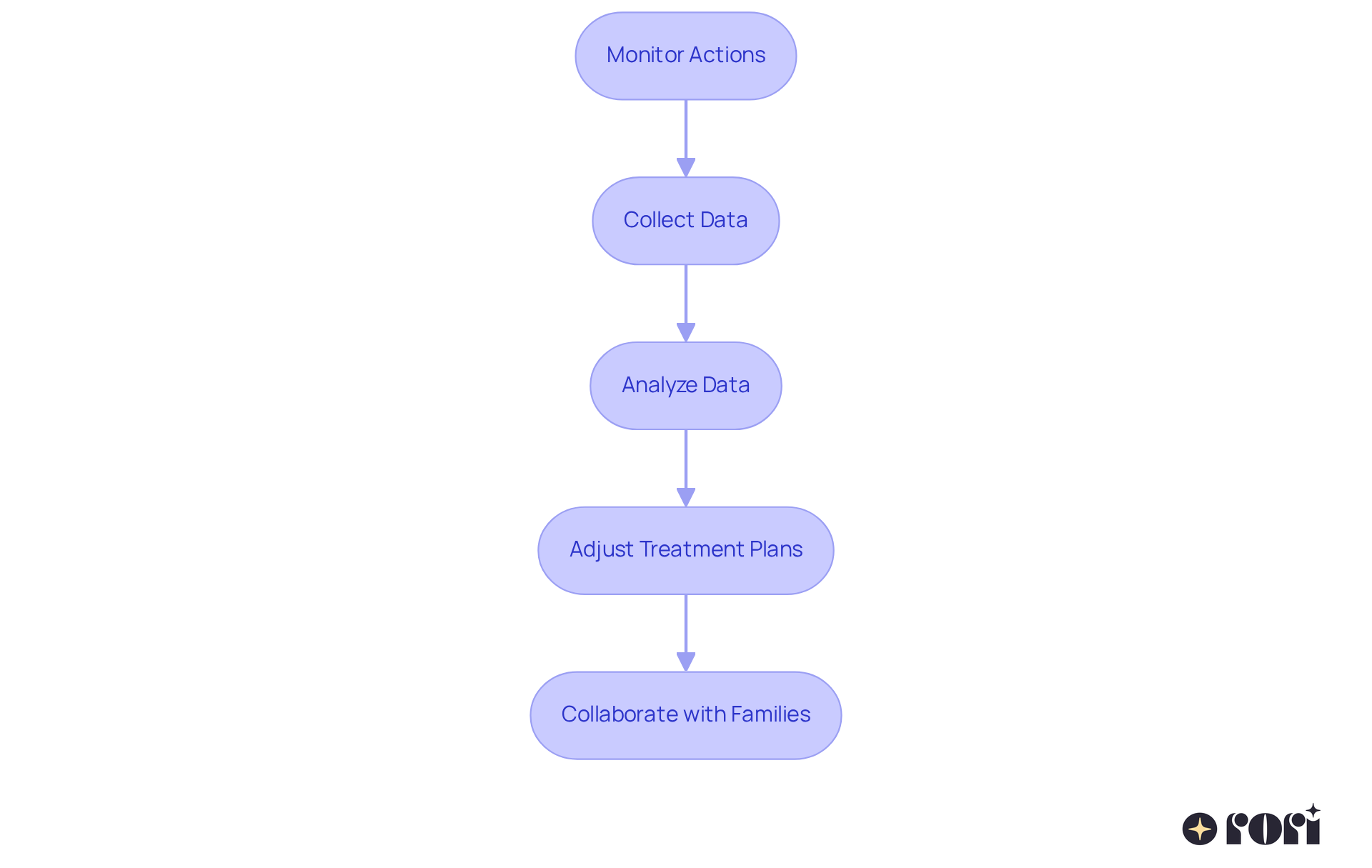
Effective implementation of Differential Reinforcement of Other Behaviors (DRO) really thrives on teamwork between parents and therapists. When parents learn to spot and encourage positive actions at home, it creates a nurturing atmosphere that helps kids grow. For instance, if a young person gets rewarded for steering clear of disruptive behavior while doing homework, parents can use similar reinforcement techniques outside of therapy sessions.
This approach not only boosts the young person's development but also empowers parents with the knowledge and skills they need to actively participate in their child's behavioral growth. As one counselor put it, "Regularly implementing techniques at home strengthens skill enhancement and fosters a nurturing environment for the young one's development."
Such collaboration really enhances the effectiveness of DRO in ABA examples, which leads to better behavioral outcomes. When caregivers feel empowered, they make choices that positively influence their child's progress. So, let’s explore this together! We’re here to help you every step of the way!
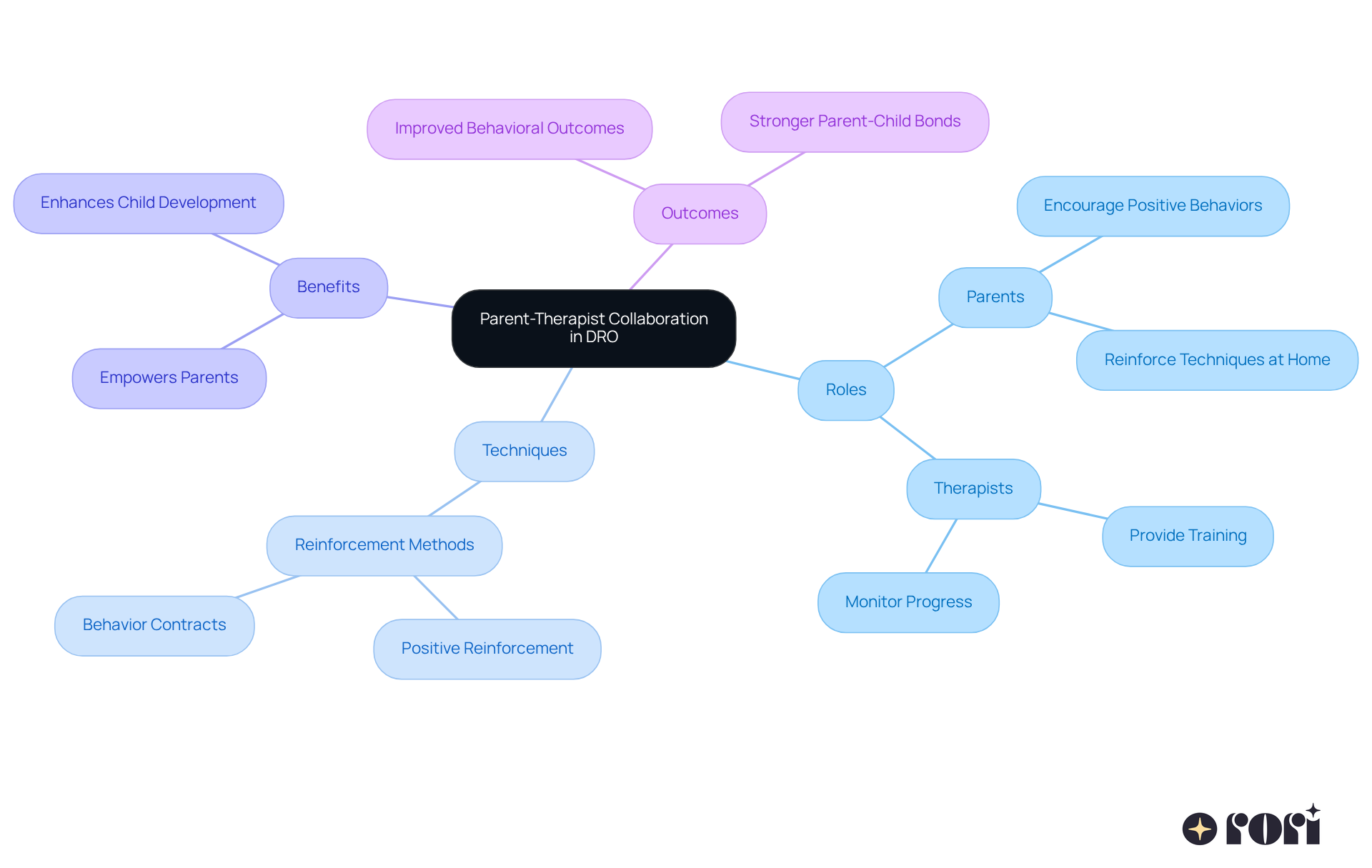
Let’s take a moment to consider a real-life scenario that many parents can relate to. Imagine a student in a classroom who often finds themselves out of their seat—about 15 times on average during the baseline phase! It’s a challenge, right? But here’s where a little strategy can make a big difference. By using a Differential Reinforcement of Other Behavior (DRO) approach, which is highlighted in DRO in ABA examples, the teacher focused on rewarding the student for staying quiet during specific times. Over several weeks, this method led to some impressive improvements in the child’s impulse control, which in turn boosted their classroom behavior and academic participation.
Now, thanks to Rori Care's conduct care engine, clinicians can perform a thorough functional analysis. This tool helps generate automatic progress reports that track the child’s development and inform ongoing strategies. Research backs this up—when DRO in ABA examples is applied effectively, it can significantly reduce disruptive behaviors. In fact, studies have shown an overall mean effect size of 1.80 across various interventions. This case really highlights how versatile DRO in ABA examples can be, demonstrating its success across various educational settings.
But it doesn’t stop there! Consistent reinforcement, educating caregivers, and conducting a functional behavior assessment (FBA) before starting are key to achieving positive outcomes. By equipping caregivers with ABA concepts and techniques, they can play an active role in their kids' behavioral goals. It’s all about making informed decisions and gathering data efficiently.
So, if you’re navigating similar challenges, remember—you’re not alone! Let’s explore this together and find the best strategies for your child!
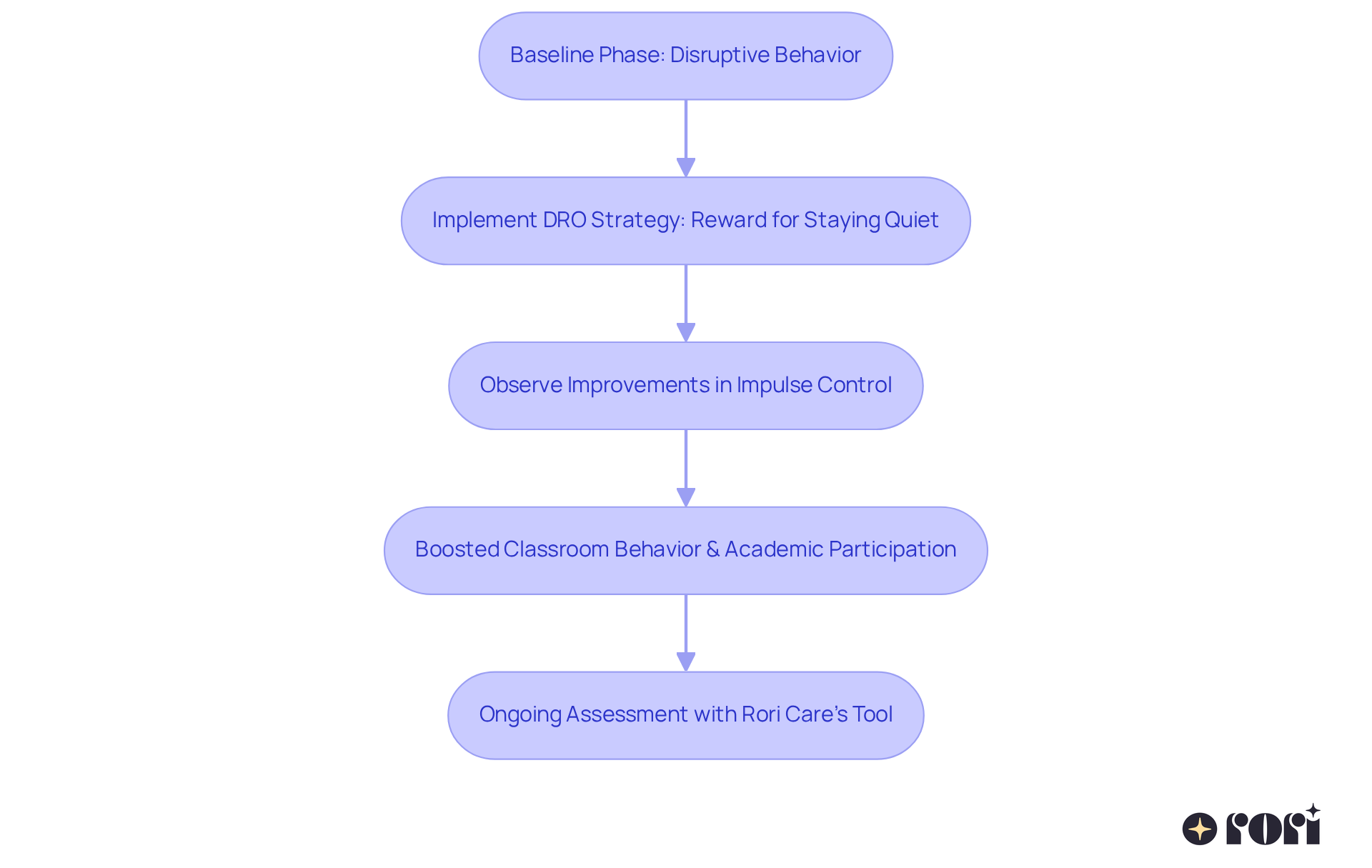
Tailoring Differential Reinforcement of Other Behavior (DRO) strategies to meet individual behavioral needs is so important for achieving positive outcomes in ABA therapy! Every child is unique and reacts differently to reinforcement schedules, which is why it’s essential to customize the approach based on their preferences. For example, some kids thrive on verbal praise and really shine when they get immediate recognition for their positive actions. Others might respond better to tangible rewards, like stickers or tokens. By understanding what each child loves and what motivates them, therapists can really boost the effectiveness of DRO strategies.
Certified analysts play a key role in this personalization. They create tailored plans that include measurable goals and evidence-based methods to encourage positive changes and skill development. Experts highlight that this personalized support makes reinforcement techniques resonate with each child, which in turn builds their self-confidence and supports their learning journey. Plus, delivering rewards promptly is crucial! It strengthens the connection between actions and rewards, which is a vital part of effective reinforcement strategies.
Case studies show that personalized methods, such as DRO in ABA examples, not only spark engagement but also lead to lasting changes in behavior. Kids who receive customized reinforcement are more likely to repeat the behaviors we want to see, as the rewards align with their interests and needs. This individualized focus is a cornerstone of effective ABA therapy, creating a nurturing environment that fosters skill acquisition and emotional growth. As Board Certified Behavior Analysts (BCBAs) remind us, "The effectiveness of this approach is significantly enhanced when reinforcement techniques are tailored to meet the specific needs of each child."
Let’s explore this together! If you’re a parent navigating these waters, remember that you’re not alone. We’re here to help you every step of the way!

Technology can really make a difference when it comes to monitoring DRO in ABA examples and strategies in therapy. With digital tools, therapists can keep an eye on actions in real-time, which means they can quickly adjust reinforcement schedules based on what’s happening right then and there. For instance, studies have shown that using mobile apps for tracking behaviors has led to a notable 9.7% increase in success rates after implementing hybrid treatment models that embrace these technologies.
And here’s something to think about: about 50% of the time spent in ABA therapy goes into writing reports. That’s a lot! This highlights just how much efficiency we can gain through these tech advancements. Clinicians have shared that apps designed for tracking behaviors not only help visualize progress but also support data-informed decision-making. This makes it easier for both therapists and parents to spot trends in behavior.
Plus, using tracking apps fosters collaboration between families and therapists, enhancing communication and ensuring that interventions are tailored to the child’s evolving needs. This real-time data collection empowers clinicians to make informed adjustments, leading to more effective and personalized outcomes in DRO in ABA examples.
Take Rori Care, for example. Their approach combines personalized therapy with advanced AI, allowing for automatic progress report creation. This means therapists can spend 50% more time focused on treatment! Apps like Proloquo2Go and MITA showcase the digital resources available for monitoring behaviors, providing practical support for parents eager to enhance their child’s therapy.
Let’s explore this together! We’re here to help you every step of the way!
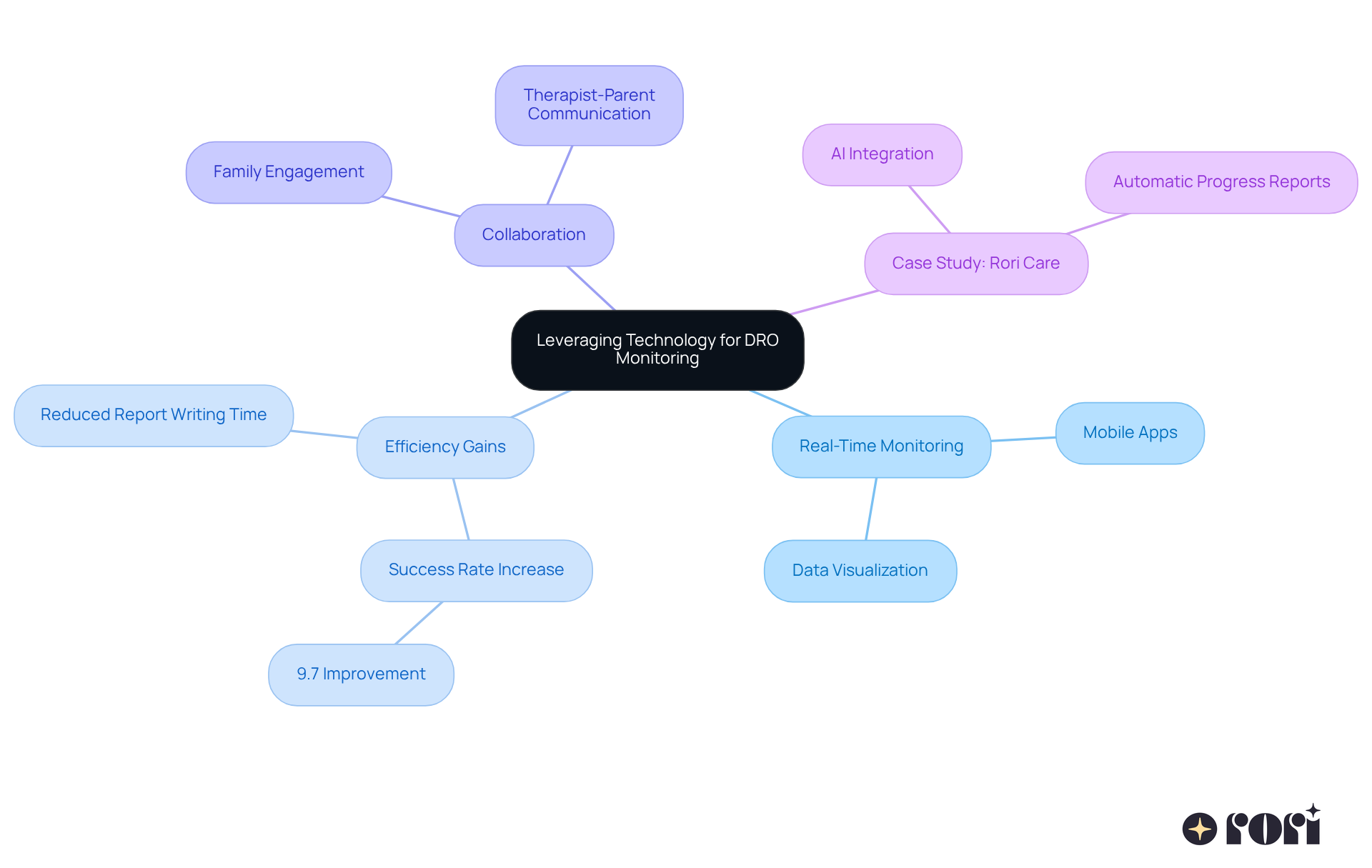
Visual supports are super helpful for young people trying to grasp DRO in ABA examples related to Differential Reinforcement of Other actions strategies. Think about visual schedules and charts—they can really show when rewards are coming, making it easier for kids to understand what to expect. Research shows that using visual aids can boost independence by 30% and improve task completion rates by 25%. Tools like First-Then boards are particularly great for keeping kids engaged in their tasks. By setting clear expectations, these tools not only help kids understand better but also get them actively involved in changing their behavior.
Now, let’s talk about the role of caregivers. When caregivers learn about ABA principles and strategies, they can provide consistent reinforcement at home, which really complements what professionals do. This teamwork often leads to better behavioral outcomes, as kids feel more prepared to handle transitions. Case studies show that kids using visual supports tend to have fewer challenging behaviors, with some evidence suggesting a drop in incidents by 20-40%. Therapists have noticed that incorporating visual aids into DRO in ABA examples boosts participation and motivation, leading to more successful behavior changes. As one therapist put it, "Visual aids not only clarify tasks but also empower young learners to take charge of their education and actions."
So, let’s explore this together! If you’re a parent looking for ways to support your child, consider how visual supports might fit into your routine. We’re here to help you every step of the way!
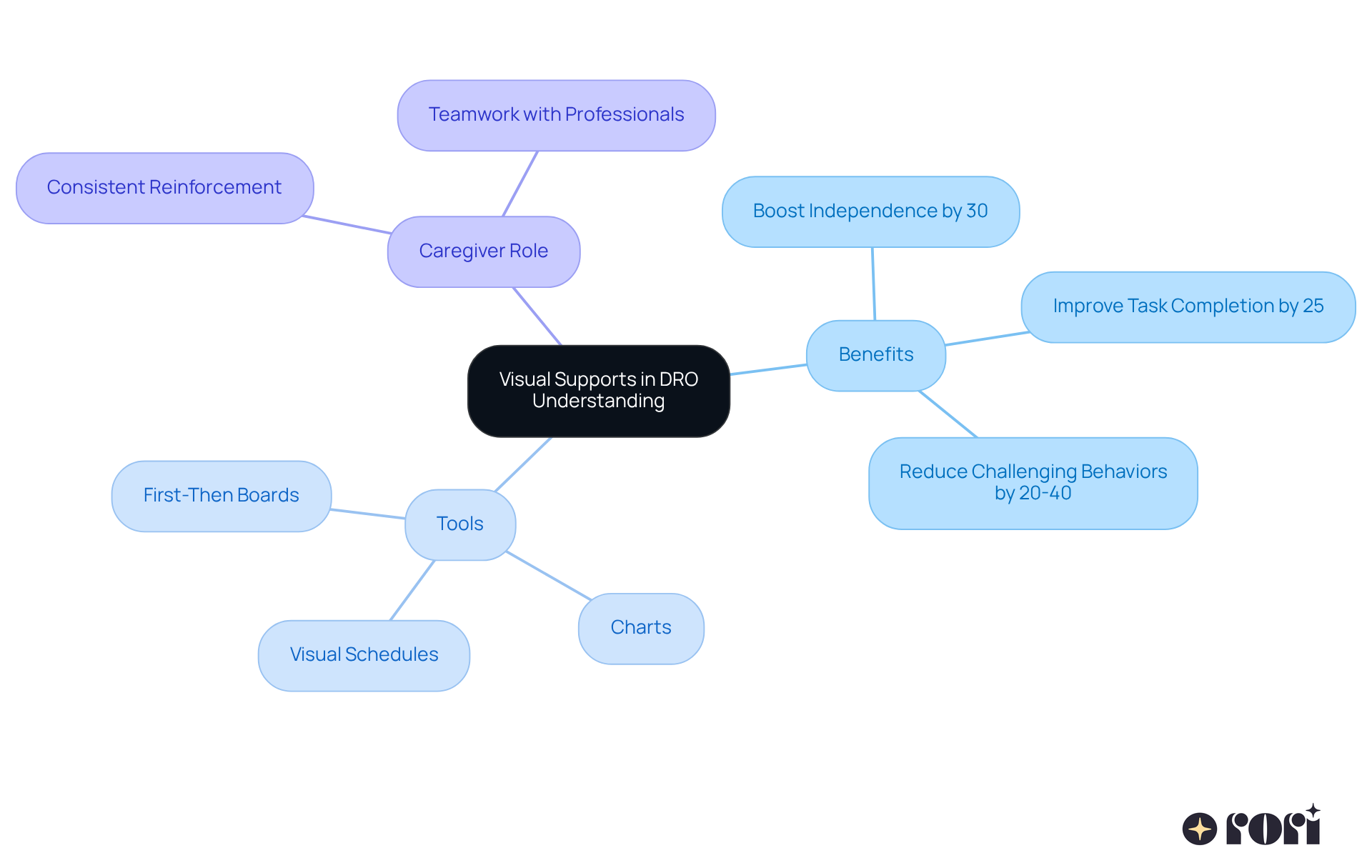
The benefits of Differential Reinforcement of Other Actions, or DRO in ABA examples, are truly amazing! It helps reduce challenging behaviors, encourages positive social interactions, and boosts overall emotional health. By focusing on the absence of negative behaviors, kids are motivated to adopt more adaptive strategies, which can lead to better relationships with their peers and caregivers. Research shows that kids using DRO in ABA examples can experience a remarkable 30% increase in positive social interactions. That’s a big win for enhancing social skills!
Now, let’s talk about how caregiver education plays a crucial role in making DRO even more effective:
There are some inspiring case studies out there! For instance, one showed a 50% reduction in tantrum episodes over six months when DRO was combined with other techniques. This really highlights the potential of DRO in ABA examples for creating supportive environments for youth with autism. As one clinician put it, "DRO not only helps manage behaviors but also allows kids to interact positively with their surroundings."
Plus, the automated data gathering process means our clinical team is always available for your child without the hassle of stopping to collect information or write reports. This data is stored securely, anonymized, and deleted after analysis, which supports caregiver involvement and boosts the effectiveness of DRO interventions.
However, it’s important to recognize that implementing DRO can come with its own set of challenges, like ensuring meaningful reinforcement and keeping things consistent across different settings. Tackling these challenges is key to maximizing the effectiveness of DRO interventions, and educating caregivers really enhances their ability to support their child’s progress effectively.
Let’s explore this together! We’re here to help you every step of the way!
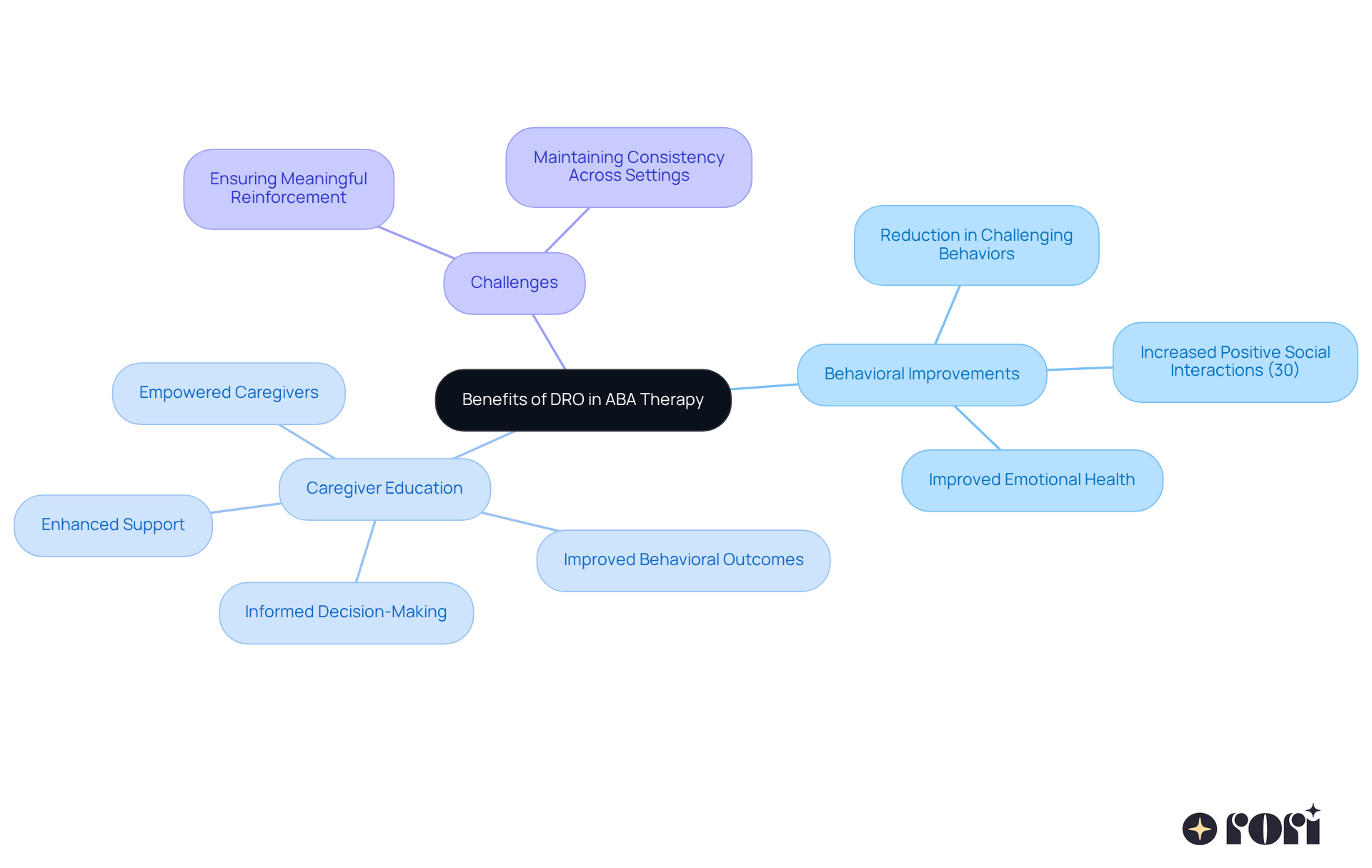
Implementing Differential Reinforcement of Other Behaviors (DRO) in Applied Behavior Analysis (ABA) therapy is a fantastic way to manage behaviors associated with autism. By focusing on reinforcing positive actions and reducing those pesky maladaptive behaviors, this approach creates a nurturing environment where children can truly thrive. The insights shared here highlight just how significant DRO can be, showing its potential to boost social interactions and overall emotional well-being for kids on the autism spectrum.
Throughout our discussion, we’ve seen some key examples of how DRO can tackle specific challenges. Think about:
Plus, leveraging technology for effective monitoring can make a real difference. It’s also clear that collaboration between parents and therapists is crucial for success. By understanding each child’s unique needs and tailoring reinforcement techniques, caregivers can play a vital role in their child’s behavioral progress.
As we wrap up, remember that the journey toward effective behavior management through DRO isn’t just about strategies. It’s about building a supportive community among caregivers, therapists, and children. As families explore the possibilities of DRO, let’s embrace the resources available, seek guidance, and actively participate in our children’s development. Your commitment to personalized care and collaboration can lead to truly transformative outcomes, making a meaningful difference in the lives of children with autism. Let’s explore this together!
What is DRO in the context of ABA therapy?
DRO, or Differential Reinforcement of Other behaviors, is a technique used in ABA therapy that focuses on reinforcing the absence of challenging behaviors during specific times to encourage more adaptive responses in children with autism.
How does Rori Care implement DRO in their therapy?
Rori Care incorporates DRO by having clinicians reinforce positive behaviors and reduce harmful actions, thereby promoting adaptive responses. This personalized approach aims to empower families and support children with autism effectively.
What benefits have been observed from using DRO in ABA therapy?
Studies have shown that children using DRO techniques have experienced a 30% increase in positive social interactions and a reduction in maladaptive behaviors, indicating the effectiveness of this approach.
Can you provide an example of how DRO is used to decrease tantrums in children with autism?
One example involves a therapist setting a timer for five minutes, during which the child is encouraged to avoid tantrums. If the child remains calm, they receive a reward, such as praise or a small treat. This method has been shown to reduce tantrum frequency over time.
What results have been documented from using DRO to decrease tantrums?
Research indicates that children who consistently used DRO techniques experienced a noticeable drop in tantrum behaviors, highlighting the effectiveness of immediate reinforcement in creating a positive association with remaining calm.
How does DRO help in encouraging positive social interactions?
DRO encourages children with autism to engage in positive social behaviors, such as sharing toys or greeting classmates, by rewarding these actions. This reinforcement helps children develop essential social skills and improve their overall social competence.
Are there any case studies that demonstrate the effectiveness of DRO?
Yes, case studies have shown significant improvements in children's focus and social interactions when using DRO techniques, illustrating its effectiveness in real-life situations.
How does Rori Care use technology in their ABA therapy?
Rori Care utilizes AI-driven tools to track progress and create reports automatically, allowing clinicians to spend 50% more time focusing on treatment, thereby enhancing the quality of care for young patients.
What is the overall goal of using DRO in ABA therapy at Rori Care?
The primary goal is to create a nurturing environment where children with autism can thrive by reducing challenging behaviors and promoting positive actions, ultimately empowering families in their support efforts.